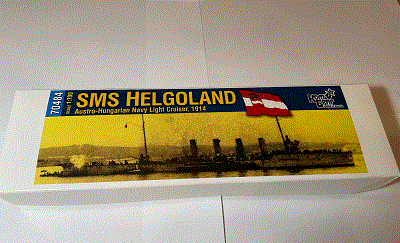Reviewed May 2023
by Christopher Martens
|
| HISTORY |
|
| SMS Helgoland was a Novara-class light cruiser and not
to be confused with the German dreadnought.
In the first days of the war, she sank an Italian destroyer, bringing
her one more kill than the dreadnought Helgoland achieved during the entire
war. In addition, she abused and sank several fishing drifters during the
Battle of the Strait of Otranto, again exceeding the dreadnought's armed
fishing trawler killstreak.
After the war, she was ceded to Italy as the Brindisi, thankfully not
to be confused with any dreadnoughts anymore, and spent the 20's doing
patrols out of Libya and Italty until she was turned into a depot ship
in 1929. She was scapped in 1937, long after the battleship Helgoland had
been broken up. It's good that the SMS Helgoland battleship was able to
beat the small light cruiser somewhere?
|
| THE HULL |
|
| Helgoland's hull, like many of Combrig's newer offerings,
is based off of excellent 3D CAD work. Impressively, the ship scales out
near perfect, with no discernable differences in her length or beam. There's
an incredible amount of detail available: coal scuttles, vents, bollards,
skylights, and other deck fittings. Bollards are very
fine, so it's possible they may get damaged in transit. I strongly suggest
that this kit is stored carefully and still with its foam protection. These
fine details are amazing, but very fragile.
In summary, this is a gorgeous hull. If you take care while storing
and building this ship, the in-scale details will absolutely blow any observer's
mind. |
|
|
| SUPERSTRUCTURE,
CONNING TOWER, AND FUNNELS |
|
| Like many WWI era ships, the
upperworks are spartan. However, what's here maintains ample, sharp detail.
I especially love that the forward part of the bridge is portrayed with
photo etch, rather than resin. The pilot house is molded solid, but this
was a solid structure.
Several details do require photo etch, like the funnel stays. For scale,
this is excellent. |
|
|
| MISCELLANEOUS
PARTS |
|
| Combrig continues their history
of extremely fine and well-molded pieces. Many of these will require careful
removal from the runners. I love that the searchlights are molded as two
pieces. As with the hull, many of these parts are extremely fine and easily
perfect. Modelers will need to tread carefully but will be rewarded with
an exceptionally beautiful ship. |
|
|
| ARMAMENT |
|
| The Novara class was equipped with 10cm main guns and nine
21in torpedo tubes. The Helgoland was also equipped with a 7cm anti-aircraft
gun. Weaponry included with the kit is both accurate and highly detailed.
Like all the other parts of this kit, you'll want to take extremely care
working with these parts. |
|
|
| SHIP'S BOATS |
|
| The ships' boats are, by far, the best options Combrig
has offered with their kits. Again, these are on par with many cutting
edge offerings from well-respected aftermarket options. |
|
|
|
|
| |
| PHOTOETCH &
FLAGS |
|
| Combrig's comprehensive photo etch set contains everything
that is needed to complete this vessel. There is minimal relief etching,
but what's offered is very good. Combrig also includes enough flags to
equip an entire armada. |
|
|
| INSTRUCTIONS |
|
| Photos below are snapshots from Combrig's instruction manual.
Instructions are intuitive, clear, and also offer in-scale sizing brass
stock needed for masts and some crane booms. Full instructions can be found
at: Conte
di Cavour's Instructions, 1940 |
|
|
|
|
|
|
| CONCLUSIONS |
|
| Combrig continues to produce kits that haven't
been comprehensively and/or qualitatively covered by other resin or styrene
manufacturers. These new kits are true multimedia kits, though often missing
masts and other brass stock scratched items. Their level of detail has
continued to improve and impress putting them at the forefront of resin
kit manufacturers. Unfortunately, given the Russian invasion of Ukraine,
however, pricing and availability may vary significantly depending on where
you live.
Thank you to both Modelwarships and Combrig
for this review sample. I will thoroughly enjoy building it. |

|



